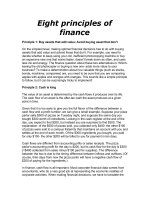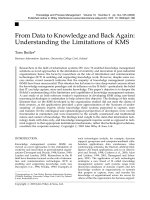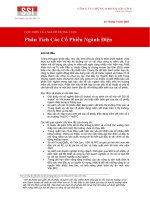THE PRINCIPLES OF AESTHETICS pdf
Bạn đang xem bản rút gọn của tài liệu. Xem và tải ngay bản đầy đủ của tài liệu tại đây (1.46 MB, 1,613 trang )
THE PRINCIPLES OF
AESTHETICS
DEWITT H. PARKER
∗
1
PROFESSOR OF PHILOSOPHY IN THE
UNIVERSITY OF MICHIGAN
PREFACE
This book has grown out of lectures to
students at the University of Michigan and
embodies my effort to express to them the
nature and meaning of art. In writing it, I
∗
PDF created by pdfbooks.co.za
2
have sought to maintain scientific accuracy,
yet at the same time to preserve freedom
of style and something of the inspiration of
the subject. While intended primarily for
students, the book will appeal generally, I
hope, to people who are interested in the
intelligent appreciation of art.
My obligations are extensive,–most di-
rectly to those whom I have cited in foot-
3
notes to the text, but also to others whose
influence is too indirect or pervasive to make
citation profitable, or too obvious to make
it necessary. For the broader philosophy
of art, my debt is heaviest, I believe, to
the artists and philosophers during the pe-
riod from Herder to Hegel, who gave to the
study its greatest development, and, among
contemporaries, to Croce and Lipps. In ad-
4
dition, I have drawn freely upon the more
special investigations of recent times, but
with the caution desirable in view of the
very tentative character of some of the re-
sults. To Mrs. Robert M. Wenley I wish to
express my thanks for her very careful and
helpful reading of the page proof.
The appended bibliography is, of course,
not intended to be in any sense adequate,
5
but is offered merely as a guide to further
reading; a complete bibliography would it-
self demand almost a volume.
6
CONTENTS
CHAPTER I. Introduction:
Purpose and Method
CHAPTER II. The Defini-
tion of Art
CHAPTER III. The Intrin-
sic Value of Art
CHAPTER IV. The Anal-
ysis of the Aesthetic Ex-
perience: The Elements of
the Experience
CHAPTER V. The Analy-
sis of the Aesthetic Experi-
ence: The Structure of the
Experience
CHAPTER VI. The Prob-
lem of Evil in Aesthetics,
and Its Solution through
the Tragic, Pathetic, and Comic
7
CHAPTER VII. The Stan-
dard of Taste
CHAPTER VIII. The Aes-
thetics of Music
CHAPTER IX. The Aes-
thetics of Poetry
CHAPTER X. Prose Lit-
erature
CHAPTER XI. The Domin-
ion of Art over Nature: Paint-
ing
CHAPTER XII. The Do-
minion of Art over Nature:
Sculpture
CHAPTER XIII. Beauty in
the Industrial Arts: Archi-
tecture
CHAPTER XIV. The Func-
tion of Art: Art and Moral-
ity
CHAPTER XV. The Func-
tion of Art: Art and Reli-
gion
BIBLIOGRAPHY
8
THE PRINCIPLES OF AESTHETICS
9
CHAPTER I
INTRODUCTION: PURPOSE
AND METHOD
Although some feeling for beauty is perhaps
universal among men, the same cannot be
said of the understanding of beauty. The
10
average man, who may exercise consider-
able taste in personal adornment, in the
decoration of the home, or in the choice
of poetry and painting, is at a loss when
called upon to tell what art is or to explain
why he calls one thing ”beautiful” and an-
other ”ugly.” Even the artist and the con-
noisseur, skilled to produce or accurate in
judgment, are often wanting in clear and
11
consistent ideas about their own works or
appreciations. Here, as elsewhere, we meet
the contrast between feeling and doing, on
the one hand, and knowing, on the other.
Just as practical men are frequently unable
to describe or justify their most successful
methods or undertakings, just as many peo-
ple who astonish us with their fineness and
freedom in the art of living are strangely
12
wanting in clear thoughts about themselves
and the life which they lead so admirably,
so in the world of beauty, the men who do
and appreciate are not always the ones who
understand.
Very often, moreover, the artist and the
art lover justify their inability to under-
stand beauty on the ground that beauty
is too subtle a thing for thought. How,
13
they say, can one hope to distill into clear
and stable ideas such a vaporous and fleet-
ing matter as Aesthetic feeling? Such men
are not only unable to think about beauty,
but skeptical as to the possibility of doing
so,–contented mystics, deeply feeling, but
dumb.
However, there have always been artists
and connoisseurs who have striven to re-
14
flect upon their appreciations and acts, un-
happy until they have understoo d and jus-
tified what they were doing; and one meets
with numerous art-loving people w hose in-
tellectual curiosity is rather quickened than
put to sleep by just that element of elu-
siveness in beauty upon which the mystics
dwell. Long acquaintance with any class
of objects leads naturally to the formation
15
of some definition or general idea of them,
and the repe ated performance of the same
type of act impels to the search for a prin-
ciple that can be communicated to other
people in justification of what one is do-
ing and in defense of the value which one
attaches to it. Thoughtful people cannot
long avoid trying to formulate the relation
of their interest in beauty, which absorbs
16
so much energy and devotion, to other hu-
man interests, to fix its place in the scheme
of life. It would be surprising, therefore, if
there had been no Shelleys or Sidneys to
define the relation between poetry and sci-
ence, or Tolstoys to sp e culate on the nature
of all art; and we should wonder if we did
not everywhere hear intelligent people dis-
cussing the relation of utility and goodness
17
to beauty, or asking what makes a poem or
a picture great.
Now the science of aesthetics is an at-
tempt to do in a systematic way what thought-
ful art lovers have thus always been doing
haphazardly. It is an effort to obtain a clear
general idea of beautiful objects, our judg-
ments upon them, and the motives underly-
ing the acts which create them,–to raise the
18
aesthetic life, otherwise a matter of instinct
and feeling, to the level of intelligence, of
understanding. To understand art means
to find an idea or definition which applies
to it and to no other activity, and at the
same time to determine its relation to other
elements of human nature; and our under-
standing will be complete if our idea in-
cludes all the distinguishing characteristics
19
of art, not simply enumerated, but exhib-
ited in their achieved relations.
How shall we proceed in seeking such
an idea of art? We must follow a twofold
method: first, the ordinary scientific method
of observation, analysis, and experiment;
and second, another and very different method,
which people of the present day often pro-
fess to avoid, but which is equally neces-
20
sary, as I shall try to show, and actually
employed by those who reject it. In fol-
lowing the first me thod we treat beautiful
things as objects given to us for study, much
as plants and animals are given to the biol-
ogist. Just as the biologist watches the be-
havior of his specimens, analyzes them into
their various parts and functions, and con-
trols his studies through carefully devised
21
experiments, arriving at last at a clear no-
tion of what a plant or an animal is–at a
definition of life; so the student of aesthet-
ics observes works of art and other well-
recognized beautiful things, analyzes their
elements and the forms of connection of these,
arranges experiments to facilitate and guard
his observations from error and, as a re-
sult, reaches the general idea for which he
22
is looking,–the idea of beauty.
A vast material presents itself for study
of this kind: the artistic attempts of chil-
dren and primitive men; the well-developed
art of civilized nations, past and present,
as creative process and as completed work;
and finally, the everyday aesthetic appreci-
ations of nature and human life, both by
ourselves and by the people whom we seek
23
out for study. Each kind of material has its
special value. The first has the advantage of
the perspicuity which comes from simplic-
ity, similar for our purposes to the value of
the rudimentary forms of life for the biol-
ogist. But this advantage of early art may
be overestimated; for the nature of beauty
is better revealed in its maturer manifesta-
tions, even as the purposes of an individual
24
are more fully, if not more clearly, embodied
in maturity than in youth or childhood.
Yet a purely objective method will not
suffice to give us an adequate idea of beauty.
For beautiful things are created by men,
not passively discovered, and are made, like
other things which men make, in order to
realize a purpose. Just as a saw is a good
saw only when it fulfills the purpose of cut-
25









